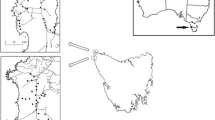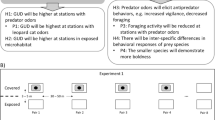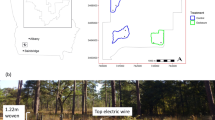Abstract
Interference competition between predators strongly influences the structure and composition of ecological communities. These interactions are usually asymmetrical as larger predators dominate in aggressive encounters. Smaller predators are forced to balance the conflicting demands of obtaining food while reducing the risk of a confrontation. We tested the behavioural responses of 16 wild captured stoats (Mustela erminea) to the presence of a feral cat (Felis catus) and a ferret (Mustela furo), which we refer to as “larger predators” due to their superior body size. Stoats were released individually into an outdoor arena and nocturnal activities were recorded on infra-red video cameras. On treatment nights, one of the larger predators was placed inside a segregated holding cage on one side of the arena, while an empty cage was placed on the opposite side as a control. A stoat’s daily food allocation was divided into two equal portions, one placed in front of each holding cage to form a food “patch”. Stoats’ perception of risk was assessed by comparing behaviour in the risky patch (close to the caged predator) versus the safe patch (close to the empty cage). Stoats harvested less food at the risky patch. They avoided the area containing the larger predator, both spatially and temporally, and increased vigilance at the risky patch. The results show that stoats alter their foraging behaviour due to perceived interference competition when they encounter larger predators. Understanding trophic interactions between invasive species will help to inform conservation decisions and maximise the effectiveness of management intervention.





Similar content being viewed by others
References
Allen C, Bekoff M (1999) Species of mind: the philosophy and biology of cognitive ethology. MIT Press, New York
Alterio N, Moller H (1997a) Daily activity of stoats (Mustela erminea), feral ferrets (Mustela furo) and feral house cats (Felis catus) in coastal grassland, Otago peninsula, New Zealand. N Z J Ecol 21:89–95
Alterio N, Moller H (1997b) Diet of feral house cats (Felis catus), ferrets (Mustela furo) and stoats (M. erminea) in grassland surrounding yellow-eyed penguin (Megadyptes antipodes) breeding areas, South Island, New Zealand. J Zool 243:869–877
Bell AM (2005) Behavioural differences between individuals and two populations of stickleback (Gasterosteus aculeatus). J Evolut Biol 18:464–473
Biggins DE, Miller BJ, Hanebury LR, Powell RA (2011) Mortality of Siberian polecats and black-footed ferrets released onto prairie dog colonies. J Mammal 92:721–731. doi:10.1644/10-mamm-s-115.1
Caro TM, Stoner CJ (2003) The potential for interspecific competition among African carnivores. Biol Conserv 110:67–75
Clout M, Karl B, Pierce R, Robertson H (1995) Breeding and survival of New Zealand pigeons Hemiphaga novaeseelandiae. Ibis 137:264–271
Creel S (2001) Four factors modifying the effect of competition on carnivore population dynamics as illustrated by African wild dogs. Conserv Biol 15:271–274
Creel S, Creel NM (1996) Limitation of African wild dogs by competition with larger predators. Conserv Biol 10:526–528
Donadio E, Buskirk SW (2006) Diet, morphology, and interspecific killing in Carnivora. Am Nat 167:524–536
Dugatkin LA (1992) Tendency to inspect predators predicts mortality risk in the guppy (Poecilia reticulata). Behav Ecol 3:124–127
Durant SM (1998) Competition refuges and coexistence: an example from Serengeti carnivores. J Anim Ecol 67:370–386
Erlinge S, Sandell M (1988) Coexistence of stoat, Mustela erminea, and weasel, M. nivalis: social dominance, scent communication, and reciprocal distribution. Oikos 53:242–246
Ferrari MC, Trowell JJ, Brown GE, Chivers DP (2005) The role of learning in the development of threat-sensitive predator avoidance by fathead minnows. Anim Behav 70:777–784
Flux JEC (2007) Seventeen years of predation by one suburban cat in New Zealand. N Z J Zool 34:289–296. doi:10.1080/03014220709510087
Frid A (1997) Vigilance by female Dall’s sheep: interactions between predation risk factors. Anim Behav 53:799–808
Fuller TK, Keith LB (1981) Non-overlapping ranges of coyotes and wolves in northeastern Alberta. J Mammal 62:403–405
Gillies C, Clout M (2003) The prey of domestic cats (Felis catus) in two suburbs of Auckland City, New Zealand. N Z J Zool 259:309–315
Hunter J, Caro T (2008) Interspecific competition and predation in American carnivore families. Ethol Ecol Evol 20:295–324. doi:10.1080/08927014.2008.9522514
IUCN (2012) IUCN red list of threatened species. www.iucnredlist.org. Accessed 23 May 2013
Keedwell RJ, Brown KP (2001) Relative abundance of mammalian predators in the upper Waitaki Basin, South Island, New Zealand. N Z J Zool 28:31–38
King CM (ed) (2005) The handbook of New Zealand mammals, 2nd edn. Oxford University Press, Oxford
King CM, Powell RA (2007) The natural history of weasels and stoats: ecology, behaviour and management, 2nd edn. Oxford University Press, New York
Kleiman DG (1989) Reintroduction of captive mammals for conservation. Bioscience 39:152–161
Kotler BP (1984) Risk of predation and the structure of desert rodent communities. Ecology 65:689–701
Kruuk H (1972) The spotted hyena. A study of predation and social behavior. University of Chicago Press, Chicago
Laundré JW, Hernández L, Altendorf KB (2001) Wolves, elk, and bison: reestablishing the “landscape of fear” in Yellowstone National Park, USA. Can J Zool 79:1401–1409
Lima SL, Bednekoff PA (1999) Temporal variation in danger drives antipredator behavior: the predation risk allocation hypothesis. Am Nat 153:649–659
Lima SL, Dill LM (1990) Behavioral decisions made under the risk of predation: a review and prospectus. Can J Zool 68:619–640
López P, Hawlena D, Polo V, Amo L, Martín J (2005) Sources of individual shy–bold variations in antipredator behaviour of male Iberian rock lizards. Anim Behav 69:1–9. doi:10.1016/j.anbehav.2004.05.010
Lourenço R, Penteriani V, Rabaça JE, Korpimäki E (2014) Lethal interactions among vertebrate top predators: a review of concepts, assumptions and terminology. Biol Rev 89:270–283
Lowe S, Browne M, Boudjelas S, De Poorter M (2000) 100 of the world’s worst invasive alien species: a selection from the global invasive species database. Invasive Species Specialist Group, Auckland
Maran T, Põdra M, Põlma M, Macdonald DW (2009) The survival of captive-born animals in restoration programmes—case study of the endangered European mink Mustela lutreola. Biol Conserv 142:1685–1692. doi:10.1016/j.biocon.2009.03.003
McArthur C, Orlando P, Banks PB, Brown JS (2012) The foraging tightrope between predation risk and plant toxins: a matter of concentration. Funct Ecol 26:74–83. doi:10.1111/j.1365-2435.2011.01930.x
McLennan J et al (1996) Role of predation in the decline of kiwi, Apteryx spp., in New Zealand. N Z J Ecol 20:27–35
Miller LA, Surlykke A (2001) How some insects detect and avoid being eaten by bats: tactics and countertactics of prey and predator. Bioscience 51:570–581
Moller H, Alterio N (1999) Home range and spatial organisation of stoats (Mustela erminea), ferrets (Mustela furo) and feral house cats (Felis catus) on coastal grasslands, Otago Peninsula, New Zealand: implications for yellow-eyed penguin (Megadyptes antipodes) conservation. N Z J Zool 26:165–174
Moseby KE, Cameron A, Crisp HA (2012) Can predator avoidance training improve reintroduction outcomes for the greater bilby in arid Australia? Anim Behav 83:1011–1021
Mukherjee S, Heithaus MR (2013) Dangerous prey and daring predators: a review. Biol Rev 88:550–563
Mukherjee S, Zelcer M, Kotler BP (2009) Patch use in time and space for a meso-predator in a risky world. Oecologia 159:661–668. doi:10.1007/s00442-008-1243-3
Müller KH (1970) Beiträge zur Biologie des Hermelins (Mustela erminea). BLV-Verlagsges, Sdngetiarkundl
Murphy EC, Keedwell RJ, Brown KP, Westbrooke I (2004) Diet of mammalian predators in braided river beds in the central South Island, New Zealand. Wildl Res 31:631–638
Nonacs P, Dill LM (1990) Mortality risk vs. food quality trade-offs in a common currency: ant patch preferences. Ecology 71:1886–1892. doi:10.2307/1937596
Palomares F, Caro TM (1999) Interspecific killing among mammalian carnivores. Am Nat 153:492–508
Parkes J, Murphy E (2003) Management of introduced mammals in New Zealand. N Z J Zool 30:335–359
Polderboer EB, Kuhn LW, Hendrickson GO (1941) Winter and spring habits of weasels in central Iowa. J Wildl Manag 5:115–119
Polis GA, Myers CA, Holt RD (1989) The ecology and evolution of intraguild predation: potential competitors that eat each other. Annu Rev Ecol Syst 20:297–330
Preisser EL, Bolnick DI, Bernard MF (2005) Scared to death: the effects of intimidation and consumption in predator–prey interactions. Ecology 86:501–509
Quenette P-Y (1990) Functions of vigilance behaviour in mammals: a review. Acta Oecol 11:801–818
R Development Core Team (2011) R: a language and environment for statistical computing. R Foundation for Statistical Computing, Vienna
Reardon JT, Whitmore N, Holmes KM, Judd LM, Hutcheon AD, Norbury G, Mackenzie DI (2012) Predator control allows critically endangered lizards to recover on mainland New Zealand. N Z J Ecol 36:141
Ritchie EG, Johnson CN (2009) Predator interactions, mesopredator release and biodiversity conservation. Ecol Lett 12:982–998
Rudzinski DR, Graves HB, Sargeant AB, Storm GL (1982) Behavioral interactions of penned red and arctic foxes. J Wildl Manag 46:877–884
Salo P, Nordstrom M, Thomson RL, Korpimaki E (2008) Risk induced by a native top predator reduces alien mink movements. J Anim Ecol 77:1092–1098. doi:10.1111/j.1365-2656.2008.01430.x
Scheinin S, Yom-Tov Y, Motro U, Geffen E (2006) Behavioural responses of red foxes to an increase in the presence of golden jackals: a field experiment. Anim Behav 71:577–584. doi:10.1016/j.anbehav.2005.05.022
Sergio F, Hiraldo F (2008) Intraguild predation in raptor assemblages—a review. Ibis 150:132–145
Sih A (1980) Optimal behavior: Can foragers balance two conflicting demands? Science 210:1041–1043
SloanWilson D, Clark AB, Coleman K, Dearstyne T (1994) Shyness and boldness in humans and other animals. Trends Ecol Evol 9:442–446. doi:10.1016/0169-5347(94)90134-1
Smith BR, Blumstein DT (2012) Structural consistency of behavioural syndromes: does predator training lead to multi-contextual behavioural change? Behaviour 149:187–213
Soulé ME, Bolger DT, Alberts AC, Wrights J, Sorice M, Hill S (1988) Reconstructed dynamics of rapid extinctions of chaparral-requiring birds in urban habitat islands. Conserv Biol 2:75–92
Vanak AT, Thaker M, Gompper ME (2009) Experimental examination of behavioural interactions between free-ranging wild and domestic canids. Behav Ecol Sociobiol 64:279–287. doi:10.1007/s00265-009-0845-z
Veale AJ (2013) The invasion ecology and molecular ecology of stoats (Mustela erminea) on New Zealand’s islands. Dissertation, University of Auckland, New Zealand
Venables WN, Ripley BD (2002) Modern applied statistics with S. Springer, New York
Vinke CM, Schoemaker NJ (2012) The welfare of ferrets (Mustela putorius furo): a review on the housing and management of pet ferrets. Appl Anim Behav Sci 139:155–168. doi:10.1016/j.applanim.2012.03.016
Wilson P, Karl B, Toft R, Beggs J, Taylor R (1998) The role of introduced predators and competitors in the decline of Kaka (Nestor meridionalis) populations in New Zealand. Biol Conserv 83:175–185
Acknowledgments
We wish to thank Mick Clout, Manpreet K. Dhami and Andrew Veale for helpful comments on the manuscript. Thanks to Guy Forrester for statistical advice. We would also like to thank Mike Wehner, Samantha Brown and Jane Arrow for their expert husbandry at the animal facility at Landcare Research. This work was supported by Core funding to Landcare Research from the Ministry of Business, Innovation and Employment’s Science and Innovation Group, with additional support through the University of Auckland Doctoral Scholarship.
Ethical standard
This research was approved by the Landcare Research Animal Ethics Committee (AEC approval number 12/06/01). Approved applications comply with the Animal Welfare Laws 1999, Animal Code of Welfare 2012 and all additional New Zealand legislation.
Author information
Authors and Affiliations
Corresponding author
Electronic supplementary material
Below is the link to the electronic supplementary material.
Stoat facing directly towards the holding cage containing the ferret (MPG 5872 kb)
The cat attempts to pounce on a female stoat (MPG 3006 kb)
The cat attempts to catch a male stoat that climbs onto the holding cage (MPG 8356 kb)
Rights and permissions
About this article
Cite this article
Garvey, P.M., Glen, A.S. & Pech, R.P. Foraging Ermine Avoid Risk: behavioural responses of a mesopredator to its interspecific competitors in a mammalian guild. Biol Invasions 17, 1771–1783 (2015). https://doi.org/10.1007/s10530-014-0833-8
Received:
Accepted:
Published:
Issue Date:
DOI: https://doi.org/10.1007/s10530-014-0833-8




